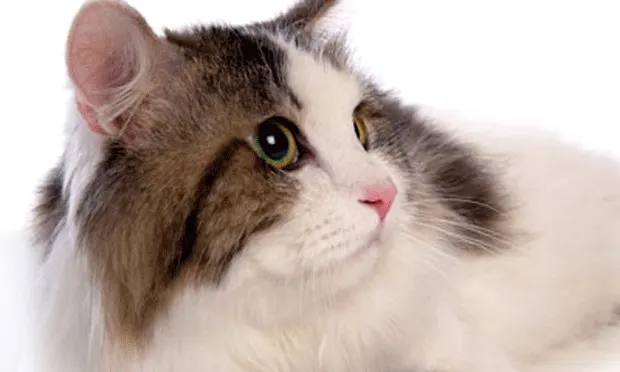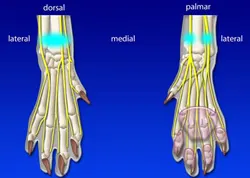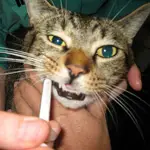Analgesia for Declaw Patients

Onychectomy in cats is controversial both within and outside the veterinary community. Passionate concerns about welfare and ethics have created an environment where discussions about the procedure and its medical complications are often avoided. Few veterinary schools teach the procedure, and there is a comparative paucity of literature about technique and analgesia for it.
Related Article: Pain Management in Cats
Amazingly, an estimated 25% of owned cats in the United States are declawed.1 Based on the frequency with which this procedure is being performed in general practices, it is important that cats undergoing onychectomy are provided appropriate and sufficient analgesia.
ONYCHECTOMYIn general, cats undergoing onychectomy have the entire third phalanx removed from their front feet. Surgical removal of the phalanx can be accomplished with a surgical blade, a guillotine nail cutter, or a carbon dioxide laser, but controversy exists within the literature regarding which procedure results in less pain.2,3 Further complicating issues are the age and size of the patient; the type of closure (tissue adhesive vs sutures), and whether bandages are used or not. Regardless of the technique, all cats undergo multiple amputations on a weight-bearing surface and should be considered to have moderate to severe pain.
Veterinarians who perform onychectomies should also be cognizant of how long cats may continue to be in pain. Declawed cats continued to have abnormal force plate analysis at 12 days post surgery.4 Consequently, analgesic therapy should be instituted for at least 3 to 5 days.
Related Article: Chronic Pain Syndrome Feline Onychectomy
PAIN PATHWAYSUnderstanding how pain is transmitted and perceived is necessary to design an effective protocol to attenuate pain. In general, for a noxious stimulus to be perceived as painful, 4 steps must occur: transduction, transmission, modulation, and perception. Briefly, the noxious stimulus (eg, toe amputation) is transduced into an afferent action potential at the level of the nociceptor. The action potential is then transmitted via an A-delta or C-fiber neuron to the dorsal horn of the spinal cord. From the dorsal horn of the spinal cord, the action potential is then carried to the thalamus, and then from the thalamus to higher cortical centers. Modulation of the signal, either amplification or attenuation, can occur at any level (peripherally, in the spinal cord, or in the brain). Finally, perception of the noxious stimuli occurs when the signal reaches the higher cortical centers and the patient “feels” the pain.
Figure 1: For onychectomy, local anesthetics may be administered as a ring block or perineurally at the level of the carpus. Courtesy Ohio State University

DRUG THERAPY OPTIONSThe goal of pain management is to decrease conscious perception of a noxious stimulus, either by decreasing neuronal transmission or by increasing attenuation of the pain signal. There is good evidence that preemptive and multimodal analgesia produces enhanced analgesia with diminished side effects. By attacking the pain pathway at several different sites, lower doses of individual drugs can be used, thereby reducing side effects while enhancing analgesia. A logical combination of analgesic drugs can be created based on each agent’s role in interrupting the pain pathway.
Local Anesthetics
IndicationsLocal anesthetics, such as lidocaine and bupivacaine, are sodium channel blockers that prevent ascending movement of pain information on A-delta and C-fiber neurons. For onychectomy procedures, local anesthetics may be administered as a ring block or perineurally at the level of the carpus (Figure 1). A 1:1 mixture of lidocaine and bupivacaine is recommended to provide rapid onset of action (lidocaine) and prolonged pain relief (bupivacaine).5 The effects of bupivacaine can be expected to last approximately 4 to 6 hours with some individual variation.
ContraindicationsCats are more susceptible to potential side effects of local anesthetics (central nervous system [CNS] and cardiac toxicity), but there are no contraindications for appropriate perineural administration during a routine onychectomy procedure.
Drug InteractionsLocal anesthetics may be administered perineurally with other analgesics.
AdvantagesPerineural administration of lidocaine and/or bupivacaine can provide full anesthesia of the feet, which will decrease general anesthetic needs, decrease central sensitization (wind-up), and provide a more comfortable recovery from general anesthesia. Additionally, local anesthetics do not alter mentation.
DisadvantagesA theoretical disadvantage to local anesthetics would be that a patient would not feel its feet and potentially walk too much following surgery, but I have not seen this complication in my practice.
Nonsteroidal AntiInflammatory Drugs
IndicationsThe inflammatory response generated by tissue trauma can be mitigated by using nonsteroidal antiinflammatory drugs (NSAIDs). Although most of the NSAID effect is due to decreasing peripheral prostaglandins and inflammatory mediators, there is likely an additional central analgesic effect. In my experience, the addition of NSAIDs to declaw analgesic regimens has dramatically improved pain states in cats. Currently, only meloxicam is approved for use in cats in the United States.
ContraindicationsNSAIDs are contraindicated in patients with moderate to severe renal or gastrointestinal disease, dehydration or hypovolemia, and in patients with coagulopathies.
Drug InteractionsNSAIDs should not be administered concurrently with other NSAIDs or corticosteroids.
AdvantagesNSAIDs are potent analgesics and antiinflammatories that do not produce CNS depression. Oral meloxicam has been prescribed off-label at low doses for chronic daily therapy in the United States and is licensed for long-term daily use in Europe.6 Studies have shown that long-term use of low-dose meloxicam is not associated with new or worsening kidney disease.6,7
DisadvantagesCats receiving NSAID therapy are susceptible to gastrointestinal side effects such as vomiting and ulcer formation.
Opioids
IndicationsPure mu-opioid agonists (eg, fentanyl, hydromorphone, morphine), partial mu-opioid agonists (buprenorphine), and kappa-opioid agonists (butorphanol) are indicated for the relief of acute pain in cats. Although butorphanol has been shown to be effective for declaw pain,8 its duration of action can be quite short in cats (approximately 90 minutes)9 and therefore cannot be recommended unless it will be administered frequently or as a constant rate infusion (CRI) to manage pain in declawed cats.
ContraindicationsPure mu-opioid agonists may cause dysphoria, bradycardia, hypoventilation, as well as nausea and vomiting. Partial and kappa agonists generally produce fewer side effects. For elective onychectomy procedures, a contraindication to an opioid would be rare.
Drug InteractionsConcurrent administration with other CNS depressants (eg, general anesthetics, alpha-2 agonists) can cause synergistic effects with increased sedation and hypoventilation. Careful monitoring of all patients following administration of CNS depressants is warranted.
AdvantagesOpioid agonists are the mainstay of acute pain therapy in humans and animals. They provide potent analgesia often with sedation, and their effects are reversible. Fentanyl may be administered via a transdermal patch that provides pain relief lasting approximately 4 days in cats. Although there is individual variability in cats treated with fentanyl patches, therapeutic plasma levels are achieved in 6 to 12 hours following placement. Buprenorphine may be administered transmucosally (Figure 2) and lasts 6 to 8 hours. Both are reasonable options for at-home, postsurgical care.

Figure 2: Buprenorphine may be administered transmucosally.
DisadvantagesOpioids can cause dysphoria in cats and/or excessive sedation. Most opioids need to be administered parenterally; only the transdermal fentanyl option or transmucosal buprenorphine is practical for owners to administer at home. Due to risks associated with accidental exposure by a child and the addictive properties of these agents in the human population, clinicians should take great care to educate clients about these concerns before discharging the animal.
Alpha-2 Agonists
IndicationsAlpha-2 agonists, such as dexmedetomidine, are potent analgesics and sedatives. The addition of dexmedetomidine to either the anesthetic protocol or as an analgesic adjunct may be of particular benefit in cats immediately post anesthesia following onychectomy. The combination allows cats to sleep longer and move around less, potentially aiding in healing and decreasing the pain of movement in the early postoperative period.
ContraindicationsAlpha-2 agonists cause an increase in systemic vascular resistance (vasoconstriction and increase in blood pressure) with an initial reflex bradycardia resulting in a significant decrease in cardiac output (approximately 50%). Alpha-2 agonists should be used with caution in cats with cardiovascular disease.
Drug InteractionsWhen administered with other CNS depressants, alpha-2 agonists (like opioids) may produce exaggerated effects.
AdvantagesSmall doses of dexmedetomidine in conjunction with other anesthetics produces potent analgesia and sedation that is associated with an excellent recovery from anesthesia following onychectomy. The effects of alpha-2 agonists are reversible, as are associated side effects.
DisadvantagesCardiovascular effects and oversedation can be associated with these drugs.
NMDA Receptor Antagonists
IndicationsN-methyl-D-aspartate (NMDA) receptors are located in the dorsal horn of the spinal cord and in the brain. Those in the spinal cord have been linked to central sensitization (wind-up) pain, and antagonizing these receptors has been shown to break the cycle of wind-up pain and prevent it from developing in the first place. I routinely use subanesthetic doses of ketamine and other NMDA receptor antagonists as a CRI to provide analgesia and prevent central sensitization for limb amputations; an NMDA receptor antagonist can be used similarly for declaw amputation.
ContraindicationsNMDA receptor antagonists increase sympathetic tone and increase intracranial pressure. Caution should be used in patients with hypertension or in those suspected to have elevated intracranial pressure.
AdvantagesSubanesthetic doses of ketamine may prevent central sensitization (wind-up) following onychectomy.
DisadvantagesKetamine needs to be administered over an extended period (approximately 24 hours) to alter central sensitization, making CRI necessary for delivery. Clinicians should be aware, however, that ketamine should not be given to cats in combination with lidocaine (such as morphine-lidocaine-ketamine premixed combinations) via CRI because of the hypersensitivity of the cat’s cardiovascular system to IV lidocaine.
POSSIBLE ANALGESIC STRATEGIESIn the current literature, reviews of analgesics for onychectomy have examined drugs or routes of administration separately (eg, transdermal vs IV, or bupivacaine vs fentanyl)4,10 with little evaluation of multimodal techniques, which makes clinical translation of current studies difficult. The Table summarizes 3 typical analgesic strategies that are based on what is known about pain pathways and drug responses in cats. Clinicians should always keep in mind that not all protocols or drugs are appropriate for all cats, and medical discretion should be used before administering any drugs.
ANALGESIA FOR DECLAW PATIENTS • Lysa Pam Posner
References1. Assessment of claims of short- and long-term complications associated with onychectomy in cats. Patronek GJ. JAVMA 219:932-937, 2001.2. Use of carbon dioxide laser for onychectomy in cats. Mison MB, Bohart GH, Walshaw R, et al. JAVMA 221:651-653, 2002.
Evaluation of short-term limb function following unilateral carbon dioxide laser or scalpel onychectomy in cats. Robinson DA, Romans CW, Gordon-Evans WJ, et al. JAVMA 230:353-358, 2007.4. Effect of postoperative analgesic protocol on limb function following onychectomy in cats. Romans CW, Gordon WJ, Robinson DA, et al. JAVMA 227:89-93, 2005.5. Local and regional anesthesia. Lemke KA, Dawson SD. Vet Clin North Am Small Anim Pract 30:839-857, 2000.6. Long-term safety, efficacy and palatability of oral meloxicam at 0.01–0.03 mg/kg for treatment of osteoarthritic pain in cats. Gunew MN, Menrath VH, Marshall RD. J Feline Med Surg 10:235-241, 2008.7. Retrospective analysis of long-term use of meloxicam in aged cats with musculoskeletal disorders and the effect on renal function. Gowan R. ECVIM Proc, p 242, 2009.8. Analgesic efficacy of preoperative administration of meloxicam or butorphanol in onychectomized cats. Carroll GL, Howe LB, Peterson KD. JAVMA 226:913-919, 2005.9. Use of thermal threshold response to evaluate the antinociceptive effects of butorphanol in cats. Lascelles BD, Robertson SA. Am J Vet Re_s 65:1085-1089, 2004.10. Comparison of transdermal administration of fentanyl versus intramuscular administration of butorphanol for analgesia after onychectomy in cats. Gellasch KL, Kruse-Elliott KT, Osmond CS, et al. _JAVMA 220:1020-1024, 2002.